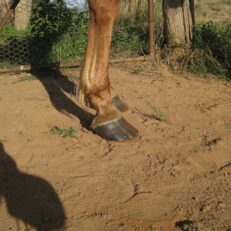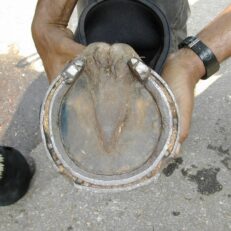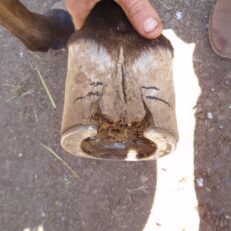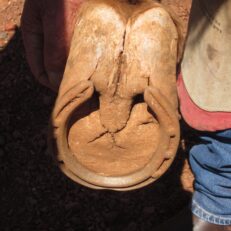Hoof-related back strain is a syndrome that is affecting both horses and riders in all forms of equine pursuits. It has always existed to a lesser degree; however it now seems to be showing up more frequently and is a problem that must be eliminated.
One cause of this hoof-related back strain in horses is incorrect hoof/pastern angle in the front feet, resulting from either long toes/low heels, or from high heels/short toes. This drastically alters the natural normal gait of the horse, so many riders then accept the fact that their horse is rough to ride and assume that the saddle must be the problem, or that perhaps they should have tuition with a riding instructor because the horse seems to be erratic in his movements or disunited.
Often this course of action leads to the discovery that the horse has muscle soreness in his upper body, anywhere in the neck and shoulders or along his back or over the hindquarters, and then the owner enlists the aid of a vet or the chiropractor. This is really only a bandaid cure because the real cause of the problem is quite simply in the feet.
Often these horses will also present with an attitude problem such as ears back, teeth bared, lowered head, sad eyes etc. but as soon as the hoof/pastern angle is corrected their action returns to normal, their whole demeanor changes and I have seen them actually smile with relief.
Let us look firstly at the long toe/low heel problem to see how it happens, and how to correct it. Regardless of whether the hoof is to be shod or unshod, it must be trimmed to be balanced. As a quick guide to measuring what needs to be trimmed before cutting, an imaginary line is taken from the coronary band above the toe to the ground, transposed across the sole of the hoof, and the result should be equidistant from front to back. With long toes and low heels (Pic 1) there is much more hoof in front of the line than behind it.
Long toes creep into the system because of the failure to pare away the excess sole in the front half of the hoof. Follow this principle and it will show you exactly how much toe is to be removed. Do not touch the heels, do not use wedges to build up the heels either, as they are only a temporary bandaid and in fact they crush the heels even further. Heel cogs do the same (Pic 2). This poor horse was in so much pain he was unable to stand on one leg long enough to have the other one inspected, and both rider and horse were having extensive chiropractic treatment!
The best and most permanent way to correct long toe/low heel syndrome, is to concentrate on trimming the overgrowth at the toes, then the heels will begin to grow normally, and the result will be the correct parallel hoof/pastern angle.
The opposite hoof problem which relates to back strain is high heel/short toes. While these are not so prevalent, they do cause action problems which in turn cause back strain. The major cause of high heels and short toes is conformation related upright pasterns. These horses are choppy in their action because the high heel dictates that the flight of the hoof is high and drops short, causing excessive jarring up through the shoulders, and ending up in the rider’s back. This type of horse usually prefers to canter rather than trot as it is easier for him to use his hindquarters than to suffer the jarring in the front end caused by trotting, and his useful working life expectancy will be short, developing joint problems early due to concussion. The best way to avoid this hoof problem is not to breed it.
However, we do have the problem, so let’s do the best we can, by paring away the excess sole and observing the high heel growth that needs to be cut away to allow the frog to contact the ground. Then, using the same measurement as before, trim the toe area lightly to a neat shape. Trimming needs to be done at closer intervals with this type of hoof; you will probably never fully correct the fault, but you will certainly stop it from getting worse.
My earlier comment, that these hoof related back strain problems seem to be getting more frequent, is no doubt due to the fact that competition is ever on the increase, plus riders are becoming more finely tuned; they are calling more frequently on support services like veterinarians and chiropractors and farriers, but sadly there is still far too much lack of consideration by all concerned when it comes to the basic understanding of the horse’s hoof, and the old saying ‘no hoof no horse’ never goes away.





